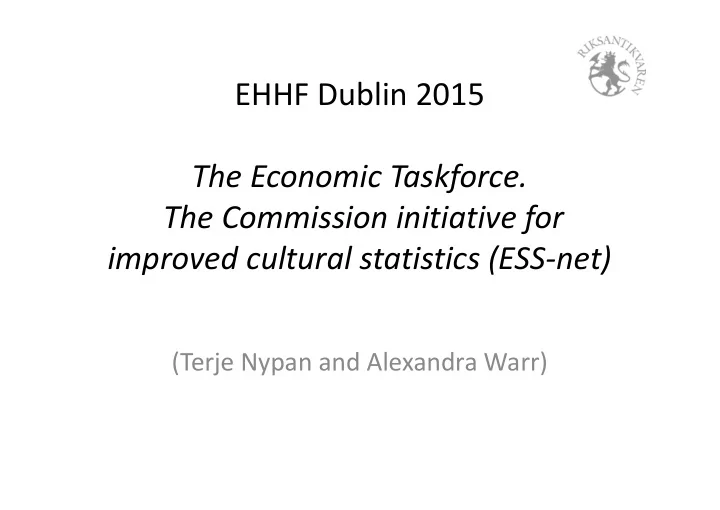

EHHF Dublin 2015 The Economic Taskforce. The Commission initiative for improved cultural statistics (ESS-net) (Terje Nypan and Alexandra Warr)
A policy initiative Consequential to � Council Conclusions on cultural heritage as a strategic resource for a sustainable Europe , � and COMMUNICATION FROM THE COMMISSION TO THE EUROPEAN PARLIAMENT, THE COUNCIL, THE EUROPEAN ECONOMIC AND SOCIALCOMMITTEE AND THE COMMITTEE OF THE REGIONS Towards an integrated approach to cultural heritage for Europe. Brussels, 22.7.2014. COM(2014) 477 final, a Commission initiative has been taken to ensure the regular production and dissemination of statistics on culture. See: Conclusions of the Council and of the Representatives of the Governments of the Member States, meeting within the Council, on a Work Plan for Culture (2015-2018). (2014/C 463/02). II D.1 This is a very positive initiative.
Renewed initiative for cultural statistics � « …. AGREE that reliable, comparable and up-to-date cultural statistics are the basis of the sound cultural policy-making and therefore statistics are a cross- sectorial priority in this Work Plan; and therefore LOOK FORWARD to the results of the work to be carried out under the auspices of Eurostat in order to ensure the regular production and dissemination of statistics on culture, while taking into account recommendations contained in the ESS-net culture report;” (2012) � Source : Conclusions of the Council and of the Representatives of the Governments of the Member States, meeting within the Council, on a Work Plan for Culture (2015-2018). (2014/C 463/02). II D.1
The challenge of ESS-net cultural concept. From the position of the immovable cultural heritage the ESS-net framework (2012) has some limitations; i.e. limited to ‘culture’ as such. The true value of (physical) heritage is measured through impact. � Craftsmen working are not cultural workers and not counted. The economic activity in the building and construction sector not counted. � Value added generated by CH as attractors for tourism not counted. Hotel and restaurant personnel not cultural workers. � Value and value added to real estate sector not counted or included. � There is opening for improvement as long as «….. taking into account recommendations contained in the ESS-net culture report;” (2012) and adjusting for the EU Council Conclusions confirming the cross-sectorial nature of cultural heritage (2014). � KEA European Affairs is presently doing a study to propose improvements.
A proposed core script. � The Flemish CH authorities and the EHHF Taskforce on economy and statistics (working in consultations with DG EAC) has distributed a core script regarding the need to improve the ESS-net concept. � Distributed and intended to form a basis for EHHF members to communicate with their national ESS-net group members. ESS-nett report, list of members p. 541-552 http://ec.europa.eu/culture/library/reports/ess-net-report_en.pdf
New meeting of the Task Force? � Fall 2015. London or Brussels � The Heads need to review their former nominations and their wish to contribute. END ESS-net.
Other relevant policy papers voted during the last year are: � Council conclusions on participatory governance of cultural heritage (2014/C 463/01). http://eur-lex.europa.eu/legal- content/EN/TXT/PDF/?uri=CELEX:52014XG1223(01)&from=EN � Conclusions of the Council and of the Representatives of the Governments of the Member States, meeting within the Council, on a Work Plan for Culture (2015- 2018). (2014/C 463/02) http://eur-lex.europa.eu/legal- content/EN/TXT/PDF/?uri=CELEX:52014XG1223(02)&from=EN � Draft Council conclusions on strengthening tourism by leveraging Europe's cultural, natural and maritime heritage . ST 14676 2014 INIT http://data.consilium.europa.eu/doc/document/ST-14676-2014-INIT/en/pdf � Draft Council conclusions on cultural and creative crossovers to stimulate innovation, economic sustainability and social inclusion – Adoption 18-19 may. http://data.consilium.europa.eu/doc/document/ST-8346-2015-INIT/en/pdf
CEN � European Norm (prEN 16883) “ Guidelines for improving the energy performance of historic buildings”, version of April 21st, 2015, is now in CEN Enquiry. � Will then come up for final CEN vote and is scheduled for release in 2016.
Thank you.
Need additional relevant indicators. Socio-economic indicators concerning immovable heritage . More specifically: � added-value generated by immovable heritage in sectors such as restoration, architecture, archaeology; � employment within immovable heritage (incl. restoration, architecture, and the archaeological sector); � integration of ‘cultural tourism’ as an intrinsic component of immovable heritage due to its transversal nature (in line with the recommendation of the European Commission); � private and public funding for immovable heritage in Europe (e.g. although it only gives partial information, private donations could be used as an indicator). Indicators concerning immovable heritage policy . More specifically: � number of protected/listed sites in absolute figures and their surface area per member state. This indicator should cover much more sites than the UNESCO ones. It can also be compared with the total building stock divided in age periods; � number and surface area of the archaeological sites per member state; � number of restoration works. � The above indicators are not exhaustive, but they represent a first proposal towards further consultation.
Recommend
More recommend